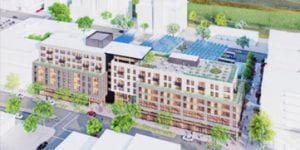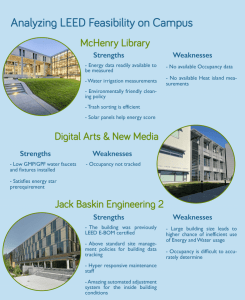LEED Lab: Assessing UCSC's Built Environment
Green Building & Purchasing
Background
Leadership in Engineering and Environmental Design (LEED) is among the most acclaimed green building rating systems in the world. A series of scorecards assign points to credit categories for which buildings do or do not exemplify sustainable criteria. Buildings that perform efficiently and sustainably are given a LEED certification and categorized as Silver, Gold, or Platinum. However, new buildings that obtain LEED certification for New Construction are not necessarily able to maintain the same level of performance when occupied. LEED for Building Operations and Management is another rating system designed for existing buildings to assess their performance by providing a framework for understanding the occupied building's impact over time.
points to credit categories for which buildings do or do not exemplify sustainable criteria. Buildings that perform efficiently and sustainably are given a LEED certification and categorized as Silver, Gold, or Platinum. However, new buildings that obtain LEED certification for New Construction are not necessarily able to maintain the same level of performance when occupied. LEED for Building Operations and Management is another rating system designed for existing buildings to assess their performance by providing a framework for understanding the occupied building's impact over time.
Updates
UCSC division of the LEED Lab is now participating in a new collaboration with the City of Santa Cruz to help perform design and energy modeling in a newly proposed Net Positive Resilient All-Electric Affordable Housing at the METRO Center. Students working with professional mentors will analyze the site for sustainability, which potentially include water reuse, living architecture, alternative energy supply, a prototype energy dashboard for transparency.
The LEED Lab at UCSC
The University of California cannot meet its Carbon Neutral by 2025 initiative if it does not understand the ongoing impacts of its buildings. In 2009, UCSC certified the flagship Engineering 2 building LEED Silver. While an impressive feat, certifying under LEED for New Construction does not hold UCSC accountable to maintain green building performance of an occupied building.
We are the UCSC division of LEED Lab, a U.S. Green Building Council (USGBC) headquartered project which prepares students for careers in sustainability. We have conducted feasibility studies on three buildings at UCSC -- McHenry Library, Digital Arts and Media, and Engineering -- following the LEED for Operations and Management rating system to evaluate water and energy use, procurement procedures, cleaning practices, access to alternative transportation, site management approaches, and other parameters of our buildings over time. The results of these studies will be used to advise the university on how their buildings are operating and what could be improved and help UCSC reach their goal of carbon neutrality by 2025. The 2017-2022 UCSC Campus Sustainability plan states an intention to “involve all students in experiential learning in the natural and built environments that comprise the campus as a living laboratory.” LEED Lab at UCSC is doing just that.

